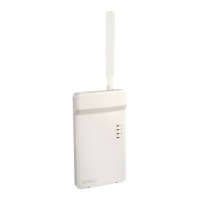4
.
All versions of the LTE/3G Alarm Communicator, operate on a LTE/3G network and are
housed inside the Self Contained Wireless Alarm System Model SCW9055/9057. The
Communicators use an Internal Antenna only.
Each version of Alarm Communicators covered by this Installation Manual are described
below:
LE2077: A Long-Term Evolution/Global System for Mobile (LTE/3G) wireless Alarm
Communicator that sends alarm communication to Sur-Gard System I-IP, II, III (SG-DRL3-
IP), IV (SG-DRL4-IP) and 5 (SG-DRL5-IP) central station receivers through an LTE/3G
digital cellular network.
CAUTION:
• Do not stay close to the equipment during device operation and to do not touch any exposed
wires and other conductive surfaces,
• Recycle the battery according to the local rules and regulations.
NOTE: Prior to installation of the LE2077, confirm with your local carrier that the LTE/3G
network is available and active in the area where the Communicator is installed, and
that the location provides a radio signal strength that is adequate for uninterrupted
service.
FEATURES
• 128-bit Advanced Encryption Standard (AES, Certificate No. 5376) encryption through
Cellular
• Activating, initializing, and remote programming through using Connect24
• Back-up or primary Cellular alarm communication
• Dual internal LTE/3G antennas
• Full event reporting to central station
• RS422 is the connection for interactive hub/gateway.
• Individual Cellular Periodic test transmission
• 2-way audio (listen-in feature) provided over Cellular
• Integrated call routing
• Remote Firmware upgrade capability of the Communicator through Cellular
• CID and SIA format reporting
• Subscriber Identity Module (SIM) card, included with Communicator
• Supervision heartbeats through LTE/3G
UL/ULC INSTALLATION REQUIREMENTS
• For ULC Residential fire and burglary applications the LE2077 can be used as primary
communication channel using Cellular (as applicable) or as a back-up in conjunction with
the Digital Alarm Communicator Transmitter (DACT). Test transmission every 24 hours is
required on each channel.
• For UL Residential fire and burglary applications the LE2077 can be used as primary
communication channel using Cellular or as a back-up in conjunction with the DACT. Test
transmission every 30 days is required on each channel.
COMMUNICATOR FREQUENCY BANDS FOR NORTH AMERICA
COMMUNICATOR TECHNICAL SPECIFICATIONS
Table 1: 3G Frequency Bands - North America
Transmit Direction Cellular 850 North America PCS 1900 North America
Transmit Frequency 824 MHz to 849 MHz 1850 MHz to 1910 MHz
Receive Frequency 869 MHz to 894 MHz 1930 MHz to 1990 MHz

